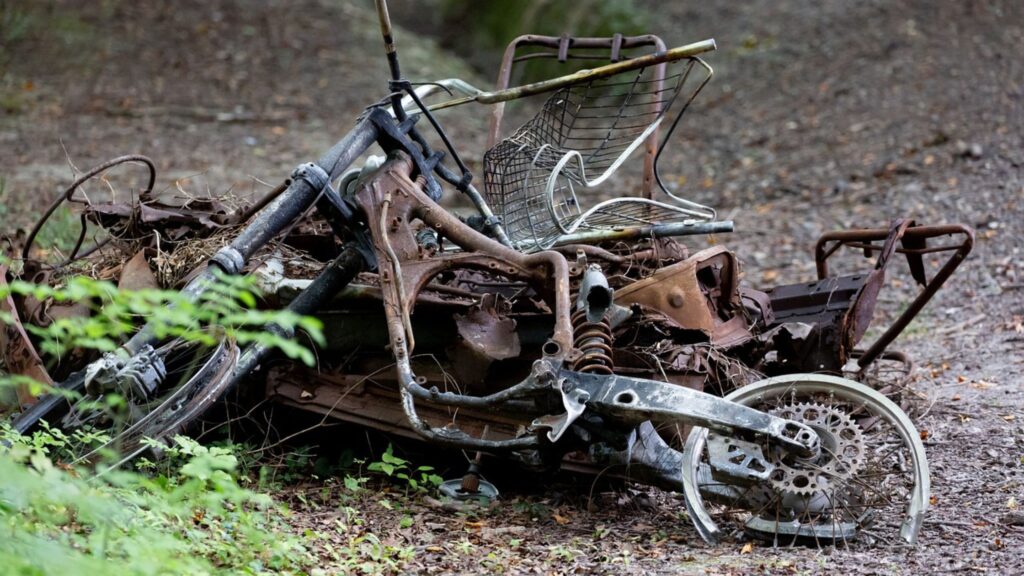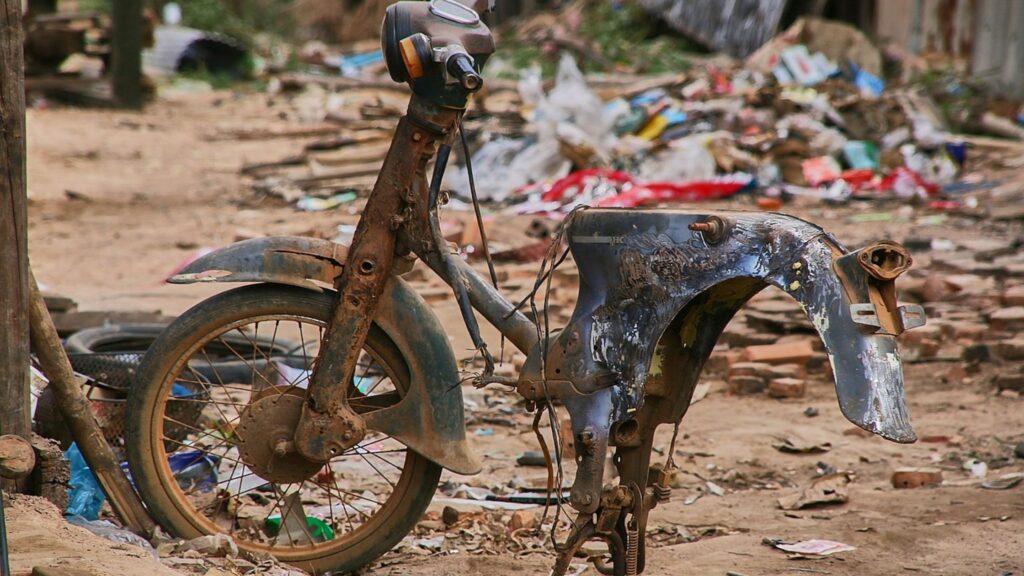Introduction

Scrap bike are motorcycles that have reached the end of their useful life due to age, damage, or mechanical failure.
Understanding the value of a scrap bike, its legal aspects, and how to repurpose it effectively can be beneficial for bike enthusiasts, mechanics, and environmentalists alike.
This comprehensive guide explores everything about scrap bikes, from their worth to selling, restoring, and repurposing them.
What Is a Scrap Bike?
These bikes often have missing or broken parts, rusted frames, or non-functional engines.
Common Reasons for a Bike Becoming Scrap:
- Accidents – Severe crashes may render a bike irreparable.
- Age & Wear – Over time, bikes degrade due to extensive use.
- Non-Compliance with Regulations – Changes in emission norms may make certain bikes obsolete.
- Engine Failure – If the engine fails and the cost of repair is too high, scrapping is the only option.
How to Determine If Your Bike Is Scrap
Frame Inspection: The frame is the backbone of any bike. Start by checking it for cracks, bends, or severe rust.
Small surface rust may be repairable, but deep corrosion or structural damage usually means the bike is beyond repair
Wheels and Tires: Inspect the wheels for warping, bent rims, or broken spokes.
Brakes and Gears: Check the condition of your brakes and gear system
If corrosion has spread to these parts, it could be a reason to scrap it.
Overall Functionality:
If your bike has multiple non-functional parts, high repair costs, and is no longer safe to ride.
It may be time to consider scrapping it.
What to Do with a Scrap Bike
Sell for Scrap Metal:
If the bike is in poor condition and beyond repair, you can sell it to a scrap yard.
Bikes are made of metal, and recycling scrap metal is an environmentally friendly way to dispose of the bike.
You’ll get a small amount of money based on the weight of the metal, especially if the frame is steel or aluminium.
Donate It:
Even if your bike is not in working condition, some organizations or community programs will accept it for reuse or refurbishment.
Local charities or bike shops may take old bikes to repair and donate to people in need. Many non-profit organizations work with communities in need, especially in developing countries, where used bikes can have a positive impact.
Repurpose Parts: If the bike is beyond repair, consider salvaging usable parts like tires, wheels, handlebars, or pedals.
These components can be reused to fix up other bikes, or they can be sold individually online or at a local bike shop.
Contact a Bike Shop: Some bike shops offer a trade-in or disposal service for old, scrap bikes.
They might offer to take your old bike in exchange for a discount on new parts or services, or they could recycle it for you.
Legal Aspects of Scrapping a Bike
Ownership Verification: It’s essential to ensure that you own the bike or have legal rights to dispose of it.
If the bike was stolen or doesn’t belong to you, scrapping it can lead to legal consequences.
Always make sure you have proof of ownership, such as receipts or registration if applicable. In some areas, bike shops or scrap yards may ask for identification to confirm ownership before accepting the bike.
Recycling Regulations: Different regions have specific laws regarding recycling, and it’s important to adhere to local waste disposal rules.
Improper disposal could result in fines or other penalties.
Environmental Laws: Scrapping a bike involves dealing with materials such as metal, rubber, and plastic. Proper disposal of these materials is essential to minimize environmental harm.
Failing to follow these laws could lead to environmental violations.
Selling Scrap Parts: If you plan to sell bike parts individually, ensure that the sale complies with local regulations.
For example, selling stolen or counterfeit parts is illegal. Be cautious when selling parts online or to third parties to avoid any legal issues.
Local Scrap Yard Laws: Some regions have strict guidelines for scrap yards, requiring them to track and report the source of scrap materials.
When taking your bike to a scrap yard, the yard may ask for documentation or identification.
These regulations help prevent illegal activities like selling stolen bikes for scrap.
How Much Can You Earn from a Scrap Bike?
The amount you can earn from a scrap bike depends on several factors, including the bike’s material, weight, condition, and where you sell it.
While the amount might not be substantial, scrapping your bike can still bring in some money.
Especially if you choose the right methods and understand the value of different components.
Here’s a breakdown of how much you could potentially earn from scrapping a bike.

1. Scrap Metal Value:
The most straightforward way to earn money from a scrap bike is by selling it for its scrap metal value.
Bikes are primarily made from steel or aluminium, and metal prices fluctuate based on market conditions.
- Steel bikes: If your bike is made of steel, the scrap value can range from $0.10 to $0.20 per pound, depending on the scrap metal market. A typical bike weighs between 20 and 30 pounds, so you could expect to earn around $2 to $6 for a steel bike.
- Aluminium bikes: Bikes made from aluminium tend to have a higher scrap value due to the metal’s greater worth. Aluminium scrap typically goes for $0.60 to $1 per pound.
- If your bike weighs 20 pounds and is made of aluminium, you could earn anywhere from $12 to $20 from selling it as scrap metal.
In most cases, the frame and some parts like wheels, handlebars, and pedals are made from metal.
The total earnings from a scrap bike will depend on the weight of the metal, so you should expect to earn anywhere from $5 to $30, depending on the bike’s materials.
2. Recycling Parts:
In addition to selling the whole bike for scrap metal, you can often make more money by salvaging reusable parts before scrapping the rest.
High-quality bike components like wheels, tires, gears, handlebars, and pedals can have some resale value, either by selling them individually or to a local bike shop.
- Pedals and handlebars: These parts can sell for $5 to $20 each, depending on their condition and brand.
- Tires and tubes: If the tires are still usable, you could sell them for $5 to $10 per tire.
By carefully dismantling your bike and selling the parts separately, you might be able to earn more than the scrap value alone.
For example, if you sell the parts individually, you could potentially make anywhere from $20 to $100.
Depending on the bike’s quality and the parts’ condition.
3. Selling to a Scrap Yard or Recycling Center:
When selling a whole bike to a scrap yard or recycling center, the yard will typically pay you based on the weight of the bike and the market price for scrap metal.
Scrap yards may also pay a little extra for bikes in decent condition or for valuable components they can reuse or resell.
4. Other Factors:
- Location: The price you can get for your scrap bike may vary depending on your location. Areas with higher demand for scrap metal or more active bike-recycling programs may offer better prices.
- Condition:
- If your bike is in decent condition and could be repaired or refurbished, you may be able to sell it to a local bike shop or through online marketplaces like Craigslist, eBay, or Facebook Marketplace. You could get anywhere from $25 to $200 for a bike that’s still usable.
- Type of Bike: Specialized bikes such as mountain bikes, road bikes, or high-end racing bikes can have higher resale values, either in whole or as parts.
- Vintage bikes or bikes with premium materials like titanium or carbon fibre may also be worth more.
Environmental Impact of Scrapping Bikes

The environmental impact of scrapping bikes, or the process of disposing of old bicycles, has both positive and negative aspects, depending on how the scrapping is handled.
Let’s explore both the positive and negative consequences of scrapping bikes and how it affects the environment.
Positive Environmental Impact
Recycling of Materials: One of the most significant positive environmental impacts of scrapping bikes is the recycling of materials.
When scrapped properly, these materials can be collected and recycled. Recycling metal, for example, saves energy compared to producing new metals from raw materials.
According to the U.S. Environmental Protection Agency (EPA), recycling aluminium saves about 95% of the energy required to produce new aluminium from bauxite ore.
Similarly, recycling steel and other metals reduces mining and extraction activities, preserving natural resources and preventing soil erosion and water contamination.
Reduced Landfill Waste:
Scrapping bikes that are no longer functional or repairable also prevents them from ending up in landfills, where they would take up space and contribute to waste accumulation.
By recycling the various components, valuable materials are reused, and waste is diverted from landfills.
This is especially important because landfills are a significant source of methane, a potent greenhouse gas, and the buildup of waste materials contributes to environmental degradation.
Using recycled materials to make new products typically consumes less energy and produces fewer greenhouse gas emissions compared to using new raw materials.
For example, recycling one ton of steel saves approximately 1,400 kilograms of carbon dioxide emissions, contributing to a reduction in the overall carbon footprint.
Negative Environmental Impact
Waste and Pollution from Improper Scrapping: While recycling is beneficial, improper disposal of bicycles can have a significant environmental impact.
Incineration produces harmful emissions, including carbon dioxide and other pollutants, while landfill disposal leads to waste accumulation and the potential for soil and groundwater contamination.
Transportation Emissions: Scrapping bikes often involves transporting them to recycling centres or scrapyards.
Trucks and other vehicles used for hauling bikes contribute to air pollution and global warming, especially if they run on fossil fuels.
The environmental cost of transportation is an often-overlooked factor when considering the full environmental impact of scrapping bikes.
Energy Use in Recycling: While recycling metals and other materials saves energy, the process of recycling itself can be energy-intensive.
For example, dismantling a bike, separating the components, and transporting.
Them to specialized recycling facilities require energy, often from non-renewable sources.

Tips for Buying a Scrap Bike for Restoration
If you’re looking to restore a scrap bike, here are some tips to consider:
1. Choose a Bike with an Intact Frame
- A damaged frame is difficult and expensive to repair.
2. Check for Availability of Spare Parts
- If essential parts are no longer available, restoration may not be practical.
3. Verify Legal Documents
- Ensure the bike has proper ownership records to avoid legal troubles.
4. Estimate Restoration Costs
- Compare the cost of repairs with the potential resale value before proceeding.
Conclusion
Scrap bikes may seem like junk, but they hold significant value in terms of parts, metal, and restoration potential.
Whether you’re selling, repurposing, or restoring a scrap bike, knowing the legal, financial, and environmental aspects.
Can help you make the best decision.
Proper disposal and recycling of motorcycles not only reduce environmental harm but also contribute to a more sustainable automotive industry.
By understanding the worth of a scrap bike, following legal procedures, and exploring creative ways to reuse it, you can turn an old motorcycle into a valuable asset rather than a waste burden.
Explore the latest collection of cars from Mr. Firoz

Recycle your junk Bike for cash

